Message in a Bottle - The Real Deal
Not the Film !
Not the Books !
Not the Movie !
But the real one started by an ancient mariner marooned alone on a deserted island, desperately trying to make contact and be rescued.
The pop group 'The Police' made a song about it, several books have been written about it , and Kevin Costner starred in a romantic film of the same title.
But what is the Real Deal? The history of Messages in Bottles? The World Records? How, When and Why? Who wrote them in the past and why? Who writes them now? How far do the bottles travel before being washed upon a beach? How long does it take for the messages to be found?
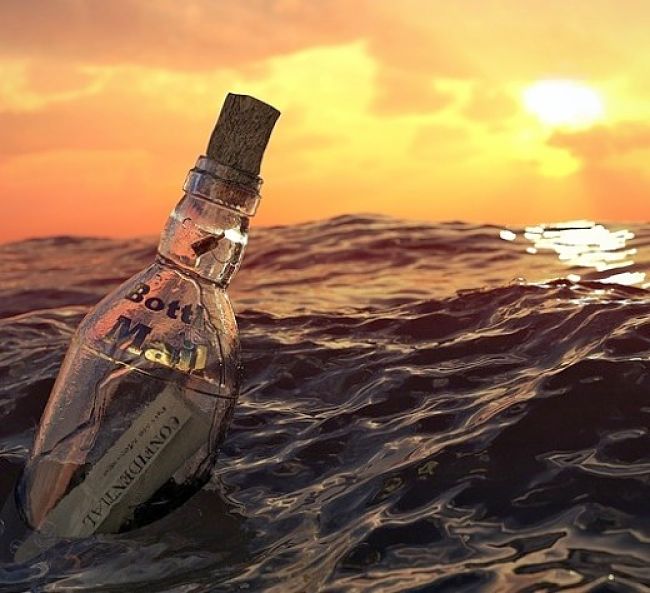
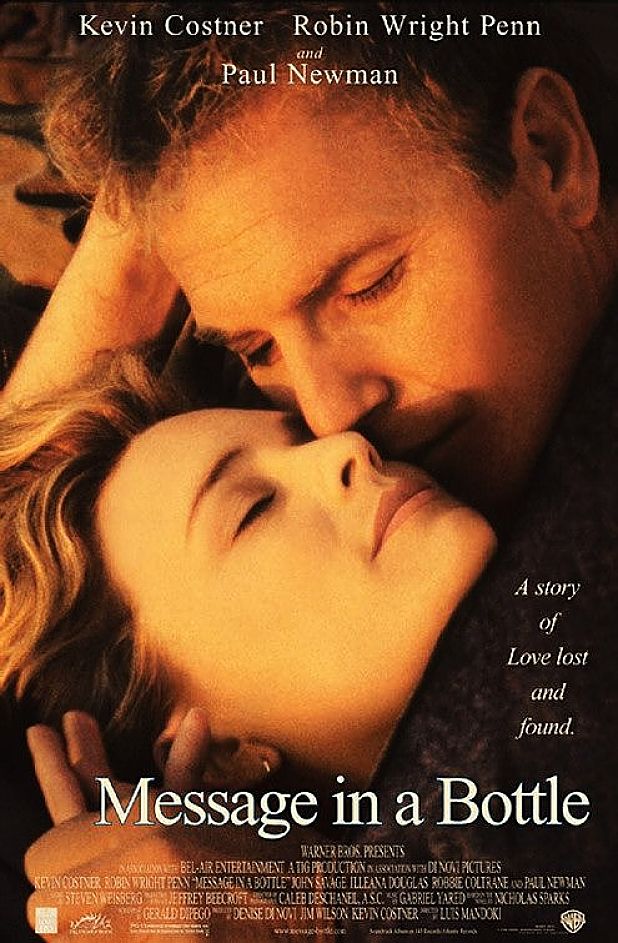
Last year my son and I released 9 messages in plastic (PET soft drink/soda) bottles from Culburra Beach, on the South-Eastern coast of New South Wales Australia. We simpy printed the message, rolled it up, with the message on the outside, and popped it into a bottle and sealed it tightly with the bottle cap. The message unrolled inside the bottle, and so could be read through the bottle wall.
I know that this is not as romantic as the rolled parchment message tied with cord of a hair braid, but it is easier to read and does the job well. Add a stone, coins or lead sinker, so that the bottle travels a little lower in the water. The ink will fade but what the Heck! Plastic is probably better than glass on a beach anyway! (check your local littering laws!)
The odd thing was that the bottles seemed to know where they were headed.
We threw the bottles out on a day with a very strong westerly offshore breeze. As we watched them we noticed that 2 bottles headed North-East, 3 went South-East and the remaining 4 headed due East. The pattern was quite distinctive.
There are similar records of directional bottle post. It has been reported that two bottles were dropped together off the Brazilian coast, one drifted east for 130 days and was found on a beach in Africa; the other floated northwest for 190 days, reaching Nicaragua.
One of our messages released from Culburra Beach in January was found 4 months later on Flinders Island in Bass Strait between Victoria and Tasmania! It had travelled a minimum of about 700 km or 435 miles. The average speed was about 0.03 km/hour or 0.01 knots. (See the Map)
It's a fun thing to do and my son wants to have another go, during our vacation at the beach.
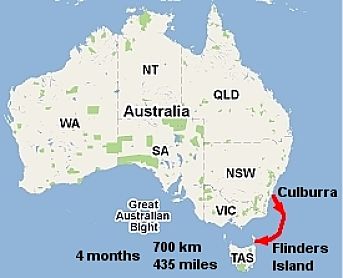
Incidentally, Jessica Watson left Sydney, in the 10.2 metre “Pink Lady”, on the 18th October 2009. She returned on 15th May 2010, after completing about 18,265 nautical miles, on her solo round the world sailing trip. She average around 9.5 km/hour or 5 knots on her voyage.
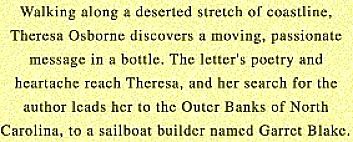
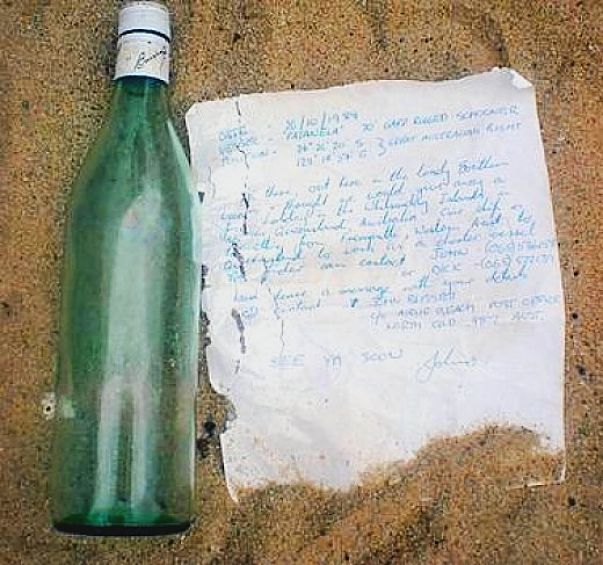
The Oldest Message in a Bottle (Guinness Book of Records)
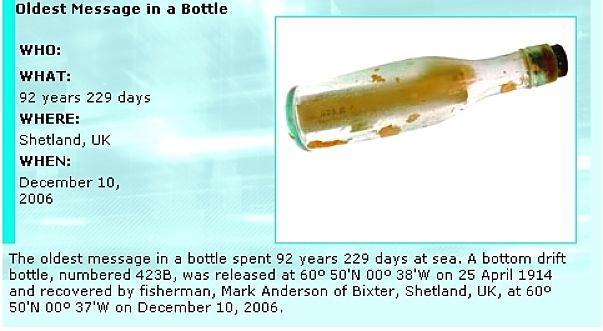
The Longest Ever Journey
Perhaps the longest ever trip was launched in the southern Indian Ocean in 1929 by a German scientific expedition. The message could be read without having to break the bottle (bottle chain letter?).
It requested that the finder tell the researchers where it was found, and throw it back into the sea. It was found, reported, found and reported again, several additional times.
The path was tracked out into the Atlantic, back into the Indian Ocean, and eventually landed on the west coast of Australia in 1935.
It had covered about 16,000 miles (7000 km) in 6.5 years (2,447 days) and averaged about 6 nautical miles a day (11 km/day, 7 miles/ day).
World Oldest Message in Bottle now 108 years!
A bottle was thrown into sea by Plymouth biologist in 1906 and found by German woman. More than 1,000 bottles were thrown into the North Sea by George Parker Bidder. This was as part of his research into sea currents. A retired German postal worker, Marianne Winkler, on holiday on Amrun, one of Germany’s North Frisian islands found the bottle and returned the postal card it contained to the Marine Biological Association, to claim the reward of one shilling. The messages returned by others helped him prove that the deep sea current in the North Sea flowed from east to west. The Association found an old shilling on Ebay and sent it to her with a letter of thanks.
History of Messages in a Bottle
- The earliest recorded messages in a bottle were those sent about 310 BC by Theophrastus, the Greek philosopher. He cast sealed messages in bottles into the Mediterranean in order to prove that it was connected to the inflowing of the Atlantic Ocean.
- In England in the 16th century the monarch, Elizabeth I, introduced a law that banned the general population from opening and reading bottle messages. She appointed an official “Uncorker of Ocean Bottles” and made it an offense to open the bottles. This was done as the messages could be from spies. The British fleet also sent regular messages about enemy positions ashore in bottles.
- Of course, marooned passengers and sailors have written and posted messages at sea for centuries. One of the most famous occurred in the in the 1700s, when Chunosuke Matsuyama and his Japanese crew of 44, were shipwrecked and marooned on a small Island in the South Pacific. The captain scratched details of their story and fate onto chips of wood and put them into a bottle. The bottle was found 150 years later on the shoreline of Japan, reportedly, close to where Matsuyama grew up.
- Benjamin Franklin as postmaster recognised that the American whaler captains knew the local currents much better than their English counterparts, and they were making faster crossings of the Atlantic. He developed a current chart based on the whalers' knowledge, and the data he received from dropping bottles into the Gulf Stream and asking the finders to return them.
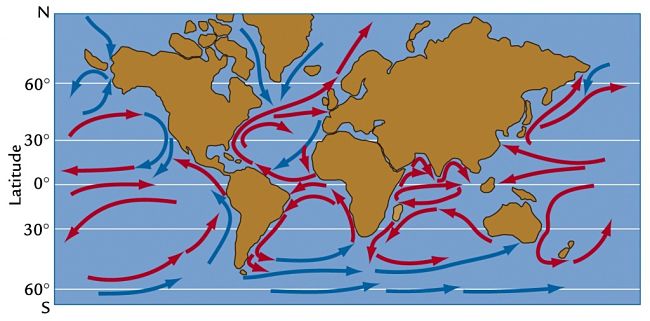
- The Warm (red) surface currents are mostly generated by winds and the rotation of the Earth. They mostly flow from the tropics to more temperate latitudes. Cold (blue) surface currents mostly flow from the temperate areas to the more polar latitudes and towards the equator. Most currents move anti-clockwise in the Southern Hemisphere and clockwise in the Northern Hemisphere. The most renowned current is the famous Gulf Stream that runs from the Gulf of Mexico towards the Northern Atlantic Ocean.
- In 1953 a weathered bottle was found on the island of Tasmania, Australia, more than 37 years after it had been cast overboard by two Australian soldiers on their way to France in a troopship during World War 1. The mother of one of the soldiers recognized the handwriting of her son who had been killed in action in 1918.
- In December 2008, Merle Brandell was walking along an isolated beach near the village of Nelson Lagoon, Alaska. He found a plastic soda bottle with a weathered letter inside. The return address was North City Elementary School in Seattle. The bottle was found a total of 21 years after being sent, and when Emily received a call from Mr Brandell to tell her of his find she was shocked and delighted.
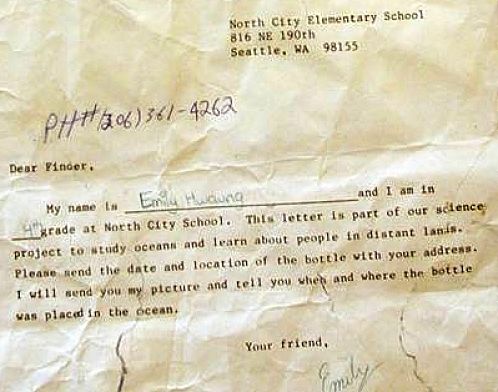
- Ake Viking, a young Swedish sailor on long boring voyage in 1956, dropped a bottle overboard with a message requesting that pretty girl who found and read the note to write to him. Paolina's father, a Sicilian fisherman, found the bottle, and as a joke passed it on to his daughter. She continued the joke, and sent a letter to the young sailor. The correspondence quickly grew. Ake visited Sicily, and the two were married soon after their first meeting in the autumn of 1958.
- A unique collection of historic messages recovered from bottles, that were used for scientific purposes is kept in the Bundesamt für Seeschifffahrt und Hydrographie (BSH) library at Hamburg and Rostock. The collection consists of about 660 bottle messages that have been found. It is probably the largest collection of messages in the world dating from 1864 to 1933 . The oldest dates back to 14 July 1864, when von Neumayer sailing on the ship named the "Norfolk", cast a message in a tightly sealed rum bottle into the sea near Cape Horn. Three years later, at 12 noon on 9 June 1867, the bottle was found by Micheal O'Donohue on the southern Australian coast, near Portland in Victoria. The bottle had travelled about 8,500 nautical miles (15,800 kilometres) at an average speed of about 8 nautical miles a day (15 km per day; 9 miles per day). This is an average speed of 0.6 km per hour, 0.4 miles per hour, 0.3 knots.
- Even Oceanography also has its funny side. For example 30,000 rubber bath duck toys in a container, went overboard more than 15 years ago during a storm in the Pacific Ocean. Since then, the rubber toys have been landing on beaches around the Atlantic and Pacific oceans. An oceanographer, Dr. Curtis Ebbesmeyer, has been investigating their drift patterns as a retirement project. About two thirds of the duck toys drifted south, and were beached on the coasts of Indonesia, Australia and South America. The rest undertook a huge voyage lasting more than 15 years. To get there, the ducks had to head through the Bering Strait that separates Siberian from Alaska. They then fought their way through the rough icy waters of Arctic Sea for several long years. They then headed south along the east coast of Greenland and finally ended up in a branch of the Gulf Stream, the North Atlantic Current, which carried them to their final destination on the coasts of northwest Europe.
- In April 2009, a high school student in a Florida, USA, put a letter in a bottle, sealed it and dropped it in the Atlantic Ocean. After 16 months the bottle was washed up on the shores of the Emerald Isle (Ireland), found by a 17-year-old and his Dad while out for a stroll.
- In 1999, a fisherman found a bottle containing two letters written by Private Thomas Hughes, dated September 9, 1914. The first message requested that anyone who found the bottle to send the second message to his wife, Elizabeth. The second letter was a lovely, simple love letter illustrating that she was in his thoughts as he traveled on a ship to France to fight in the early days of World War I. The fisherman who found the bottle located her descendants in Auckland, New Zealand. The New Zealand government paid for the fisherman to fly to Auckland to deliver the note from the bottle to the relative of Private Thomas Hughes.
- A bottle dropped into the rough waters of the Baltic Sea was found 9 years later in San Francisco, America. The bottle, with numbered message '4,764,' was one of 13,000 dropped into the ocean at Oresund between Sweden and Denmark on August 7, 1976, by the East German Institute for Marine Studies in Warnemuende.
- In 1948 a Russian fisherman discovered a message in a bottle written in English and Norwegian. He had the note translated and it read: “Five ponies and 150 dogs remain. Desire hay, fish and 30 sledges. Must return early in August. Baldwin”. The note in the bottle was from polar explorer Evelyn Baldwin who 'posted' it 1902.
- At Lorne on the south coast of Australia, Michael and Pete Lawrence found a message in a bottle washed up on a rocky cove. Mr Li Haibo, a resident of Luoyang in China, wrote the letter to break the monotony of working aboard a fishing ship as he sailed from Argentina to Spain in 2005. Michael and Pete contacted Mr Li and as a result, they spent a week in central China as the guests of the Luoyang Daily News. They were astounded by the reception they received all through their trip. They spent some time together, sharing stories over a beer or two. Mr Li wrote a new message, put it in a bottle, and dropped it into the Yellow River. A copy of that message was given to Mr Lawrence, who took it back to it Lorne to cast it into the Tasman Sea. The message contained the story of Mr Li's original message and how it was beached on the shores of southern Australia.

Space Versions of a Message of a Bottle
NASA, the U.S. space agency has effectively launched several space versions of "messages in bottles." Bolted to the frames of Pioneer 11 (launched on April 5, 1973) and Pioneer 10 (launched on March 2, 1972) were special graphic messages. The messages were in the form of 9 by 6-inch gold-anodized aluminium plaques (shown below).
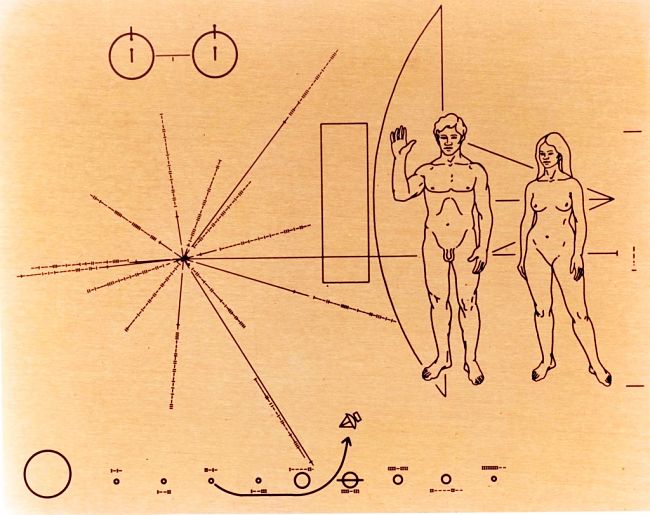
In August and September 1977, NASA launched the two Voyager spacecraft. Each carried a 12-inch gold-plated copper disk, containing recorded sounds of Earth, and images representing human cultures and life on Earth. Simple diagrams on the cover represent the origin of the spacecraft and provide instructions for playing the disk.
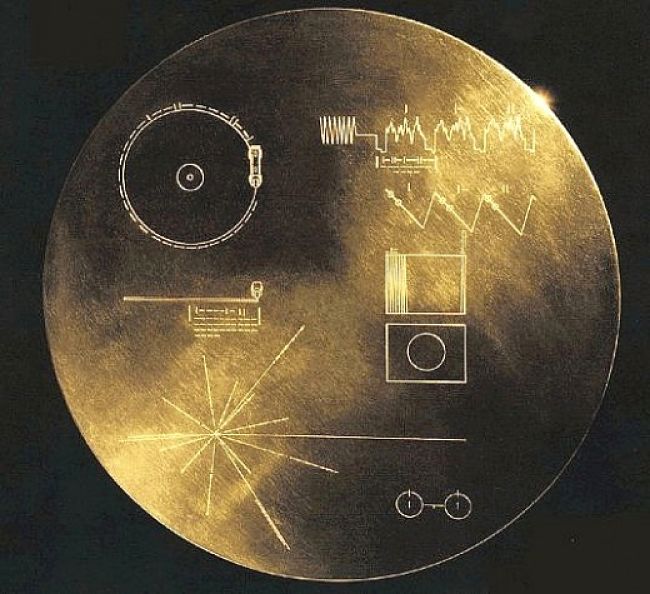
Social Network Versions of a Message in a Bottle
It was inevitable that several websites have been developed for sending "messages in a bottle" through Cyber Spaces via the Internet.
Oceangram message in a bottle is the internet (Cyber Space ) version of sending a message in a bottle. You write the message on a paper scroll, seal it in a bottle which you select, and send it off into the Cyber ocean. Someone from around the world in Cyber Space may pick it up from the ocean and read it. In order to receive a message, you just go to the site, enjoy the view and watch the ocean, and a bottle may just come floating by.
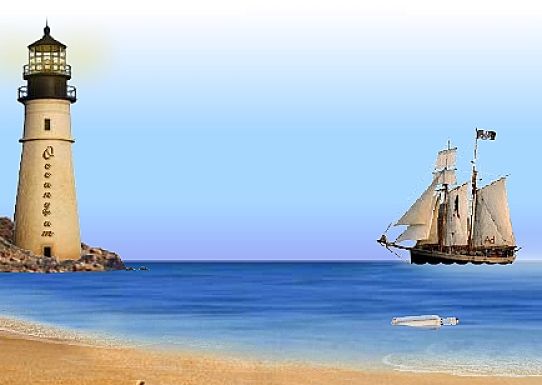
Update: Longest Time at Sea Now 108 Years
The 'Oldest' message in a bottle record is likely to be updated by a new discovery. One of 1000 bottles released by the Marine Biological Association of the UK, between 1904 and 1906, was found by a woman on a beach in Amrum, Germany. Inside the bottle was a postcard asking the the postcard be returned to the Marine Biological Association. Marianne Winkler found the bottle in April while on holidays on the German island about 310 miles (500 km) away from where it was released. The finder returned the postcard and recieved an old English shilling, the agreed reward for returning the postcard, was dutifully sent by the association to honour the original agreement.
The existing world record for the oldest message in a bottle is 99 years and 43 days, for a bottle found west of the Shetland Islands in July 2013.
Update 2: Longest Time at sea is now 134 Years
World's oldest message in a bottle found by beachwalker in Australia
The Gin bottle was thrown overboard from a German ship before ending up on a beach in Western Australia 132 years later. The bottle found in Western Australia had a message that noted the ship’s coordinates and name, plus the date it was thrown into the sea.
onya Illman found the 132-year-old gin bottle in the dunes near Wedge Island in January. Her husband, Kym Illman, initially thought it was rubbish but picked it up because it had distinct, raised lettering and would be at home on their bookshelf.
Inside, she found a roll of paper printed in German and dated to 12 June 1886, which was authenticated by the Western Australian Museum.
“It was an absolute fluke. It won’t get better than than this,” said husband Kym Illman.
The bottle had been thrown overboard from the German sailing ship Paula in 1886 as it crossed the Indian Ocean, 950km from the Australian coast, according to Ross Anderson, the museum’s assistant curator of maritime archaeology. At the time, German ships were conducting a 69-year experiment that involved throwing thousands of bottles into the sea to track ocean currents. Each message was marked with the ship’s coordinates, the date, and the name of the ship, which Anderson used to verify the message.
Details from the Illmans’ message matched Paula’s maritime records, and Anderson also compared handwriting samples with captain’s entries in Paula’s meteorological journal. “Incredibly, there was an entry for June 12, 1886, made by the captain, recording a drift bottle having been thrown overboard,” Anderson said.
His finding was confirmed by experts at the German Naval Observatory. The previous record for oldest message in a bottle was 108 years. Of the thousands jettisoned, 662 other messages from the same German experiment have been found and returned before the latest discovery. The most recent was found in 1934.